LEARN How to Use the CIRCLE OF FIFTHS in a Simple Way, so you can know the Chords of a Song, Change Key, Compose, or Modulate.
What is the Circle of Fifths
The circle of fifths is a tool widely used by musicians to know the notes and chords that correspond to a specific key. Something vital to compose our own accompaniments, transpose the chords of a song to a different key, or extract the chords of a song once its key is known.
Since each musical theme is associated with or has its own key, or several tonality in the case of passing from one tonality to another in the same piece of music. This process is known as modulation.
There is a way to summarize the charts we saw with all the notes of all the keys in the section “Notes of the Major and Minor scale“, and it would be with the Circle of Fifths.
The circle of fifths is simply a clever and effective way to cram those two charts into a much more compact diagram.
Circle of Fifths
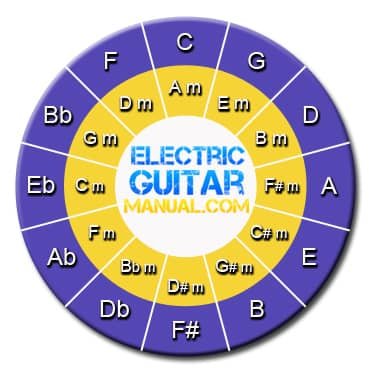
Circle of Fifths: Major and Minor Scale
In the blue circle we have the major keys, scales or chords (M – 7 – M7 – 6 – M9), and in the yellow circle the minor keys (m – m7 – m6 – m9). When I talk about major or minor chord, I mean all major or minor chords. It can be a major chord, major seventh, or major ninth for example, and in minor the same…, it can be minor, minor seventh, or minor ninth.
For example, if we want to know which notes make up a certain scale or key, we just have to follow the pattern shown in the image below for major keys, and the following one for minor keys.
Circle of Fifths: Major Scale Notes
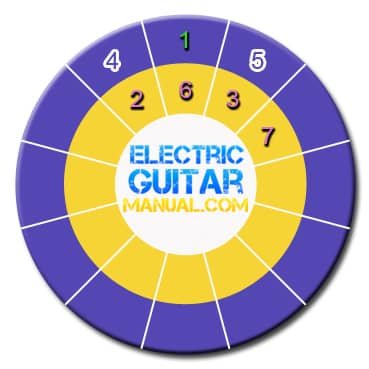
Circle of Fifths: Minor Scale Notes

This would be the arrangement of the notes of the Major and Minor Scale in the circle of fifths, but without defining any particular key. This way, you can use this pattern anywhere on the circle of fifths. Like this you’ll know exactly which notes make up any major or minor key.
In addition we will learn about the complexity of a key, depending on its number of sharps or flats. Although the circle of fifths itself has a pattern, which quickly informs us about this issue. Since the difficulty increases as we move away from the key of C Major or A minor. These two keys are the only ones that have flats nor sharps.
Flats and Sharps on the Circle of Fifths
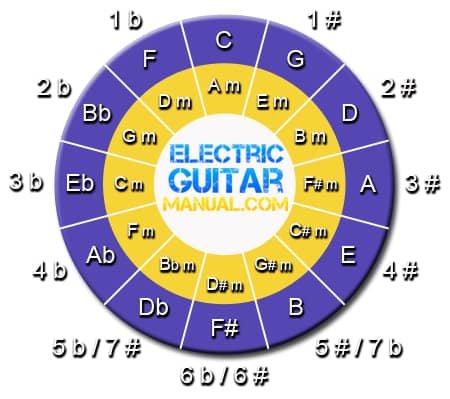
What Chords to Use in Each Key
To know which chords to use in each key, we would follow the patterns shown previously, with a slight variation for the seventh chord. Since the diminished chord is not very useful, it would be more common to find this degree a semitone lower and in major, if this degree appeared in a song.
Circle of Fifths: C Major Scale Chords
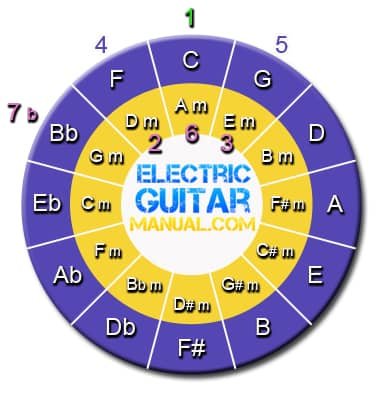
If we take a major key like C, and we want to know what chords we have to use to play in that key, we just have to look around to discover them.
To the right of C is its 5th, or fifth degree of the C scale, which would be the note G, and to the left is its 4th (F). Well, by doing this, we would already know the primary chords of the tone of C. These chords would be major, and widely used in the most popular compositions.
Just below C and inside the yellow circle, we have its relative minor (A minor). Another chord that is widely used in most songs. To the left of A minor we have the 2nd of C (D minor), and to the right would be the 3rd (E minor).
The 7th chord, or seventh degree, would be to the left of the 4th degree, but a semitone lower (B flat), and it would be played in major. I have already mentioned this before, as a diminished 7th chord is very difficult to find in popular music.
In fact, 7th grade is not used much either, since the chords that have the greatest prominence are those that are around the tonic note.
But it’s not about being rigid either. For example, we can use passing chords between notes, such as using an A flat major chord to go from A minor to G major. Therefore, the sequence would be A minor, A flat major, and G major.
That intermediate dissonance will give the sequence an enigmatic and mysterious touch that can be interesting on certain occasions.
Major Scale Degree Names
In the chart below I remind you of the name of each note, with its specific degree in the blue boxes.
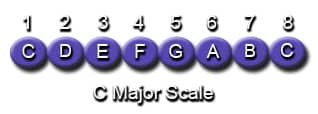
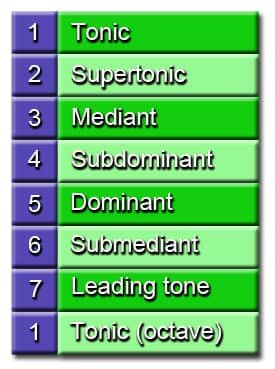
For example: if we want to compose or know the chords of a song in the key of A, the circle of fifths shows us the chords that would be used in that key. Indicating their flats or sharps, and the corresponding chords in Major or Minor. We would only have to study the order of placement, for the specific song.
Those notes or chords for key of A are: A (1st) – B m (2nd) – C# m (3rd) – D (4th) – E (5th) – F# m (6th). The most commonly used chords would be those found wall to wall with the tonic or 1st. In this case it would be A and its three neighbors D (4th) – E (5th) – F# m (6th). G would be the flat 7th, right next to the 4th degree, D.
Chords in the Key of A Major in the Circle of Fifths
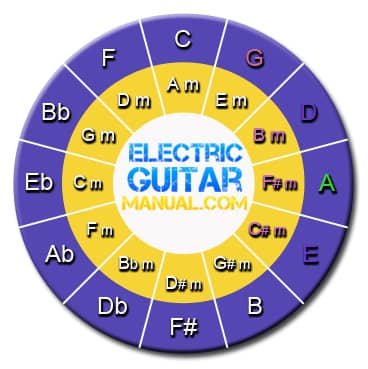
The flat 7th chord (in the above case G Major) would be the most likely chord to use in the key of A Major. But if we want to know the exact notes that make up the A scale, we would have to look in the completely opposite direction.
That is, if we find the flatted seventh next to the 4th Note (D), we find the seventh next to the 3rd Note (C#m). In the case of the A Major scale, that seventh degree that would complete the scale would be G#m.
Chords in Major and Minor keys
This would be the arrangement of notes for both the major and minor scales, but without defining any particular key. This way, we can use this pattern in any position on the circle of fifths.
Circle of Fifths: Major Scale Chords
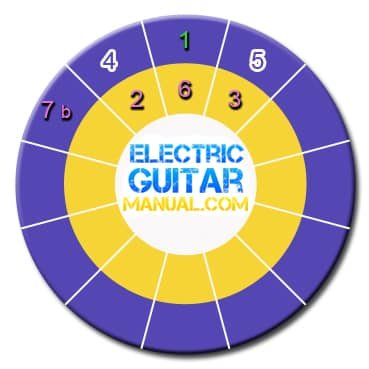
Circle of Fifths: Minor Scale Chords
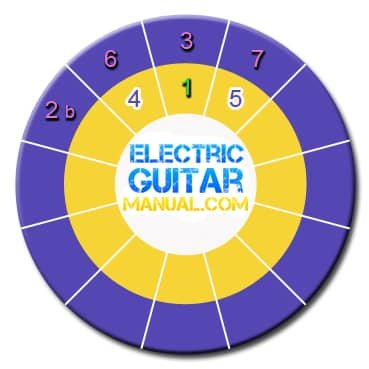
How to Change the Key of a Song With the Circle of Fifths
The simplest and most effective modulations are changes in key between scales with great similarity between the notes of which they are composed. These scales are known as closely related keys.
For example, if we want to go from C to A minor, which is the relative minor of C, and is made up of the same notes as the C scale, the process would be very simple. Since we can go directly to taking the A minor scale, after finishing a time in C. In this way we would find ourselves in the new key, making a very smooth modulation.
The example that appears below is a very simple sample built with the same degrees of both scales (1st – 4th – 5th). Drastic but at the same time soft modulation (without dissonance), due to the agreement between both scales.
C Major to A Minor Key Change

In the circle of fifths we have those aforementioned closely related keys described. For example, from the key of C, we can move to the five keys that are around it in the circle of fifths, easily and smoothly, without the ear detecting strong changes. Those keys would be F – G – Dm – Am – Em.
As you can see, the possibilities are very extensive, since we can use this same method in any key that interests us, both in the blue circle (Major), and in the yellow (minor).
Closely Related Keys in the Circle of Fifths
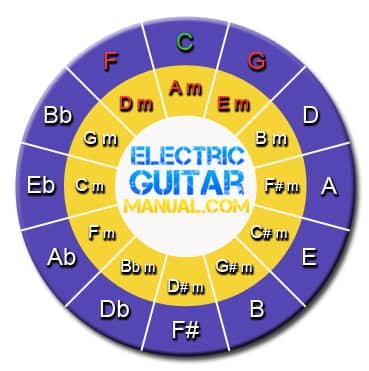
The common chords that share two different scales are the doors that open to us to be able to modulate between both scales, and thus be able to go from one key to another.
If you want to delve deeper into modulation techniques and their different types, you can consult the page dedicated to Musical Modulation.
